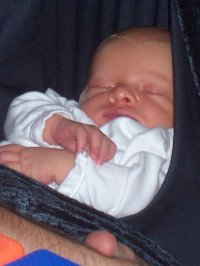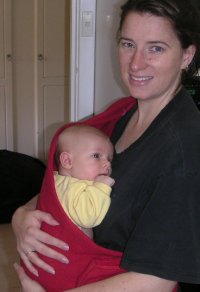Baby Wearing and Elimination
Communication
 5 simple keys to
success when wearing the EC baby
5 simple keys to
success when wearing the EC baby
by Charndra Josling
Baby wearing is a
key aid to developing your diaper-free or nappy-free confidence.
Baby wearing helps me care for my baby in
so many ways. Early morning, he 'wakes up' in the sling before going about his day.
On outings, it is a boon to quick trips in and out of the shops, keeping baby
(now toddler) held close and safe.
The close contact, non verbal communication,
conversations and kisses enable me to fully enjoy the in arms stage of his life.
We share warmth, touch, viewpoints, conversations with others and life’s
experiences. As humans are a carrying species, carrying our babies is what they
expect, and they soon relax so close to our bodies – even after a full
emotional storm or big bump on the head! We are just as soothed by smoothing
them in the sling and kissing their snuggled in head.
Baby Wearing Builds
Your EC
Confidence
Wearing your baby really helps you to be in
tune with your baby's needs. It turns up the volume on your 'baby radar' and
kicks into action your motherly (and fatherly) intuition. You simply learn, and
then begin to 'know' when your baby needs to go to the toilet. Parenting becomes
simpler - you need your baby and a sling, that is all! That sense of being a
primal mother/infant 'dyad' really becomes the truth. Babies need to be in their
parents arms, and toddlers love to be there just as much!
Baby wearing is my number one solution to a 'missy' day. These days he'll practically pitch a
fit before peeing on me in a carrier. Many a day I have worn him just to avoid
having misses! I had to wear him for an entire week at 10 months as we had workmen renovating
our ensuite - I only had a miss during the few times he was on the floor, and
had several completely EC perfect days - so COOL! Great for confidence through
the mobile stage of more misses with changing signals and patterns.
Whichever sling or carrier you use, expect to have a stage
of adjustment as you learn to recognise baby’s signs and signals, and then to
react in time! It is easier than you might think by following these 5 simple
keys to success:
-
 Choose a carrier that has good ‘poppability’
– that is, you can fairly easily work out your own system of quickly
popping baby out and back in for a wee break. Use more structured or snug
wraps for when baby is sleeping on you or is wearing a nappy.
Choose a carrier that has good ‘poppability’
– that is, you can fairly easily work out your own system of quickly
popping baby out and back in for a wee break. Use more structured or snug
wraps for when baby is sleeping on you or is wearing a nappy.
-
Practice at home! Pop baby in and walk around
when baby is feeling calm and in a good general frame of mind, so they don’t
get spooked by the new contraption. A good first time for using a
new carrier is when they are due for a sleep – pop them in and head out
for a walk so they fall asleep and wake up in there and you can pop them out
for a timing wee when they awaken.
-
When learning baby’s signs, ALWAYS put them
in the carrier AFTER they have just done a wee – this way you know they
are more likely to be relaxed and feel comfortable. Plus, you will have a
space of time of this ‘normal’ behaviour before the need to wee changes
their behaviour.
-
At first, use a cloth nappy on the baby to
protect the carrier, perhaps loosely on the baby so you can remove them
swiftly for a pee-op, or wrapped around or sitting under them (though it is
tricky to arrange at first! You might even settle baby in the sling, make a
note where their bottom is by looking in the mirror and marking the area
with some chalk, then putting a backup cloth in that area for a time.
-
Be aware of sudden changes in baby’s behaviour
that may indicate their need to go. Based on your feel of their patterns and
timing, pull them out and offer a wee…
There is a simple equation with practicing EC and
baby wearing:
The
more you hold your baby, the less you will need to use nappies!
This
is because we are a carrying
species, that is, baby expects to be carried
and it aids in their normal development.
Before
long wearing a baby simply means nappy-free time, as it is SO much easier to
respond, and nappies just get in the way.
5 common signs for a need to go
while in the sling (and it will depend on the type of carrier)
-
Changes in baby’s body tension, general body
language (use your awareness)
-
Sudden noises, un comfortable noises from
smaller babies, Vocal calls from older babies and toddlers
-
Twitching, tensing, straightening legs, pulling
up their legs, straining at the sling.
-
A feeling of warmth on your own body – as if
baby has had an accident (yet no accident there!) – this is known as the ‘chi-pee’,
‘psychic pee’ or ‘phantom wee’.
-
Facial tension changes, eye contact, frowning.
 Learning to wear baby
Learning to wear baby
Well, I love baby wearing, love the philosophy, the reasons behind it,
the
benefits, and
the closeness. However, I found it tricky. Many a time I threw the sling against
the wall in frustration! Having no help in real life was a major bummer. Reading
instructions on the internet and looking at photos wasn't enough for me - there
was always some little bit I didn't get.
I'm sure seasoned baby-wearing experts would have laughed at the dramas I had!
Turns out they are pretty common.
We had very good
success with the red polar fleece pouch - only when going for a walk would he go
off to sleep in it - so we did this every day! Then I made a wrap sling, and
that was useful for a while. I used an ABA
Simplicity Sling for some months - didn't realise it could be a back carry
until I'd moved on to a ring sling and packed it away though.
I managed the kangaroo carry at last with the ring
sling - he was happy in it, but not so good for EC as he is sort of in the
classic position that way.. At seven months I could do the hip carry (after
wrenching my back trying it at 6 months!) and that was the revelation stage for
us - I could carry him nappy free in it, and respond SO EASILY to the warmth
signal (Chi pee) on my hip.
Of course, in time I DID learn how to use carriers, and
eventually even met others who used them!! I went to a baby wearing class run by
Jenny who founded The
Baby Wearer and Kate of Wild
Slings,
learnt all the little minutiae I needed, tried a bunch of different carriers,
lovely!
The 'In-arms' phase
This stage, during the baby's first year in particular is so important for
many many reasons. It is hardly surprising then that practising EC with a babe
in-arms, and 'attached' is easier and the way to go in building confidence and a
strong connection, and getting your connection back on a 'rainy' day. Read:
The
Importance of the In-Arms Phase
More insights into baby wearing and EC will be at the new site -
be sure to join up for your free membership!
Learn
Part Time Elimination Communication (EC)
Click on the appropriate banner below to visit the Baby Wearing and EC page...
Back to top Tribal Baby © 2012 Charndra Josling
 Tribal Baby
Tribal Baby
 5 simple keys to
success when wearing the EC baby
5 simple keys to
success when wearing the EC baby Choose a carrier that has good ‘poppability’
– that is, you can fairly easily work out your own system of quickly
popping baby out and back in for a wee break. Use more structured or snug
wraps for when baby is sleeping on you or is wearing a nappy.
Choose a carrier that has good ‘poppability’
– that is, you can fairly easily work out your own system of quickly
popping baby out and back in for a wee break. Use more structured or snug
wraps for when baby is sleeping on you or is wearing a nappy. Learning to wear baby
Learning to wear baby
